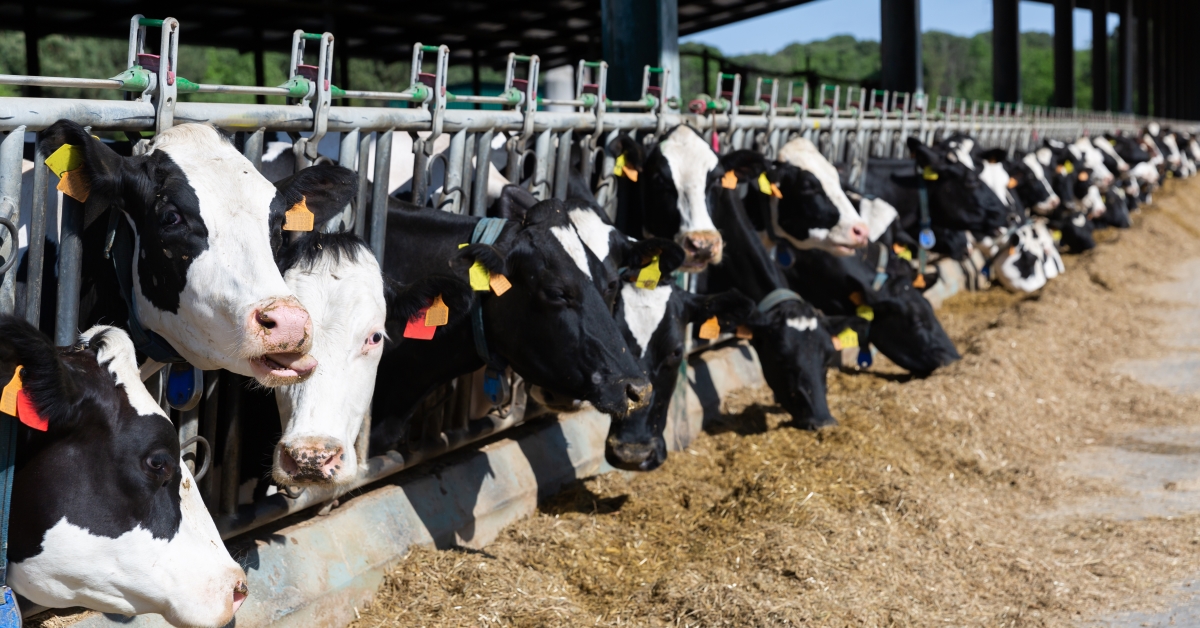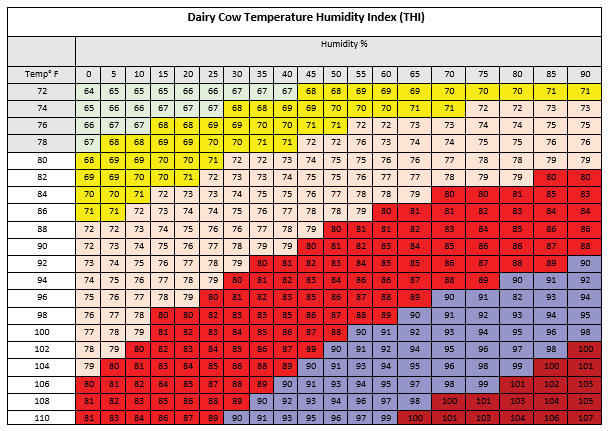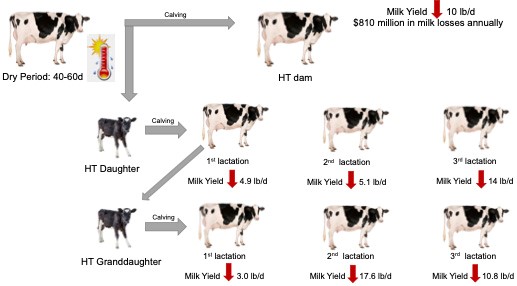
Summertime is quickly approaching, but is your facility prepared for the next heatwave? In the dairy industry, heat stress is one of the leading causes of decreased milk production and fertility in the summer months. In the United States, more than $1 billion is lost annually as a result of poor performance during periods of heat stress. With approximately 9.37 million cows currently in the US, that equates to more than $106 of lost revenue per cow annually. As the value of a hundredweight of milk climbs, so do the potential monetary losses from heat stress.
Heat stress is nothing new to the dairy industry. It comes around every year when the temperatures start climbing. What does change is our knowledge of the impact of heat stress on herd performance and our understanding of the efficacy of heat abatement strategies. For this discussion, we should review some important heat stress numbers:
- >68: Temperature Humidity Index (THI) where mild heat stress begins in dairy cows
- 80: The THI where moderate to severe heat stress begins
- 10–25%: Decrease in milk production
- 2: Hours/day more a cow will spend standing during heat stress (THI > 70)
- 4: Pounds of milk/day that will be lost due to increased standing time
- 1,000–2,500 lbs.: Reduced milk yield in the lactation after dry cows experience heat stress
Declines in intake and milk production are the most notable effects of heat stress on dairy. However, heat stress can negatively impact reproduction, lameness and immune function. For years, it was understood that the indirect effects of heat stress, such as reduced feed intake, explained the decrease in milk production in heat-stressed animals. We now know decreases in performance are not entirely explained by the reduction in feed intake but are partially explained by changes in animal metabolism. This indicates that heat stress directly affects metabolism and productivity independent of reduced feed intake. Most recently, researchers have found that heat stress negatively compromises the intestinal wall of the animal, which allows for an increased absorption of bacteria and bacterial components termed “Leaky Gut.” The leakage of bacteria into the blood supply initiates an inflammatory response that may, in addition to lowered feed intake, explain the decreased milk production due to heat stress. Identifying flexible management strategies through nutritional supplementation can help to decrease heat stress susceptibility.
Temperature Humidity Index: Table 1 illustrates the THI for dairy cows. The cells shaded yellow in this table indicate the temperature and humidity where mild heat stress begins. For humans, heat stress begins above 80°F and 40% humidity, but in dairy cows, it begins at 72°F with >40% humidity or a THI of 68. Milk production can be negatively impacted, even with mild heat stress.
By far, proper evaporative cooling systems are the most effective means of controlling moderate to severe heat stress in dairy cattle in low humidity climates. Sprinklers over the feedbunk with fans are the best method to cool cows in barns where humidity is present. Sprinklers allow the water to soak through the hair and onto the skin, which, in combination with the fans, enables cows to dissipate more heat. At higher temperatures, fans alone are not adequate to allow the cow to cool down.

Dry cows and their offspring can also be negatively impacted by heat stress. Research from the University of Florida has shown that exposure of dry cows to heat stress negatively affects milk production by reducing milk yield on average by 10 lbs. per day in the next lactation. Additionally, the effects of in utero exposure to heat stress on survival, milk production, reproduction across multiple generations have now been quantified, and those impacts persist for at least three subsequent lactations.

Figure 1: Diagram of heat stress effect during late gestation. Daughters and granddaughters born from heat-stressed dams produced less milk up to 35 weeks post-partum in all three lactations. Adapted from Laporta et al. (2020).
Heat stress can also have a significant impact on reproduction. When heat stress occurs, conception rate can decrease by 53%. Additionally, estrus expression, follicle development and embryo growth/survivability are reduced as body temperature climbs. These heat stress-related changes can greatly reduce pregnancy rate, further decreasing farm profitability.
Other management options to reduce the impact of heat stress on cattle:
- Extra emphasis on clean and abundant water and stalls in the summer months.
- Feed during cooler periods of the day to minimize heating of TMR.
- Make sure animals have access to shade.
- Ensure blades on fans are clean, as dirty fans can decrease airflow by approximately 50%.
Dietary adjustments to reduce the impact of heat stress on lactating cattle:
- Feed more digestible forages to high production cows, which will reduce heat produced during digestion.
- Adjust rations to optimize microbial protein, bypass fat, electrolytes, yeast, direct-fed microbials, organic trace minerals and other ingredients to aid in heat stress tolerance and focus on rumen health.
- Consider additives, such as ThermoCAD, to aid in reducing heat stress.
Common fan and soaker recommendations:
- Fans: Space fans 10x diameter apart from each other (2x for HVLS fans). Turn on at a temperature >68°F to ensure a wind speed of at least 7 mph anywhere that cows congregate.
- Soakers: Locate soaker line 5–6 feet above cow platform at the feedbunk with approximately 5-foot nozzle spacing, with large water droplets and 15–20 lbs. psi of water pressure. Recommended settings at 70°F are water on for one minute and 12 minutes off. Temperatures over 82°F require water on for one minute and then off for four minutes, with the goal of evaporating off 75–80% of the water before the next cycle
Minimizing the effects of heat stress on your herd through management and nutritional interventions will help keep you profitable this summer and beyond. Talk to your Hubbard Dairy Nutritionist for more information on heat mitigation strategies.
- Log in to post comments
